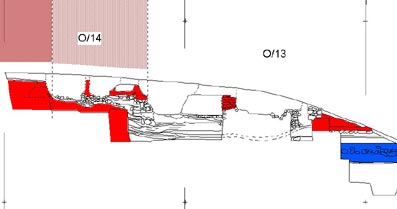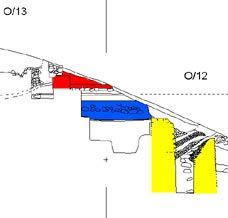
The Iron Age
In the upper and lower parts of the profile are remains of walls from the Iron Age, when the site was supplied with thick walls at the edge of the plateau (O/14). From these extended an upper terrace with small rooms, presumably intended for living quarters, storage etc.

The exterior edge of the terrace is heavily eroded, but in O/12-11 are remains of a brick foundation, which supported the outer part of the terrace. The actual edge of the terrace must be preserved deeper down in O/11, but here a thick layer of later wash has not yet been completely removed.



In the lower part of the profile (in O/7-6) is a thick wall of bricks which represents the edge of a lower terrace. Building remains on this terrace are preserved in O/10-9. The lower terrace seems to have been built in a later phase of the Iron Age, perhaps contemporary with the founding of Level II.

The Late Bronze Age

In O/13-12 are remains of buildings from the Late Bronze Age (ca. 1600-1200 BC), which seem to use the Level VIII stone terrace as outer edge. The nature of fortification system(s) during this period is not yet clear. Possibly an older city wall is present deeper in O/14.
The Middle Bronze Age

Remains from this period can be seen in O/12-11 and in O/5. In the centre of O/12 is an enceinte from level IX, remarkably preserved up to 4 m in height. Extending from this is a descending floor surface, interrupted by erosion in O/11, where instead is an older floor surface of Level X (the corresponding enceinte has been exposed in Area G, immediately under that of Level IX). Approximately from the centre of O/11 these early levels are covered by a thick layer of later wash. The unusual preservation of the Level IX enceinte is due to the fact that it was covered by a later, level VIII construction, a series of stone settings which ended in a glacis-like terracing down the slope.

Probably remains of stone terracing preserved at the bottom of the slope in O/5, and resting on bedrock, belong to this system.

It is hardly feasible to reach bedrock in the entire stretch of the trench, but it seems that Aushariye, during the Middle Bronze Age, had a main enceinte at the edge of the plateau, and sloping glacis-like constructions down to the foot of the cliff.
The fairly small areas as yet excavated for these early periods render a precise dating difficult, but Levels X-VIII belong in the period ca. 2000-1700 BC.

